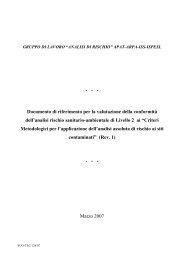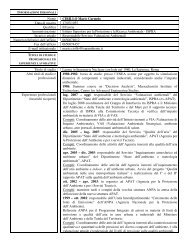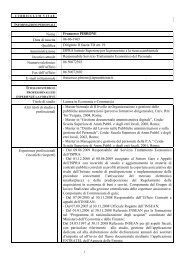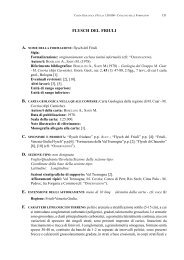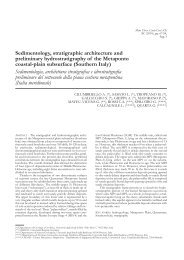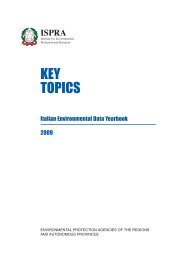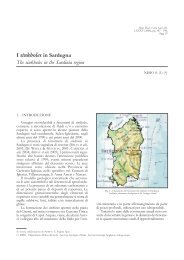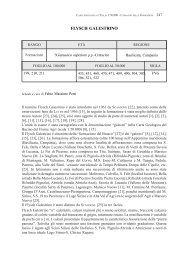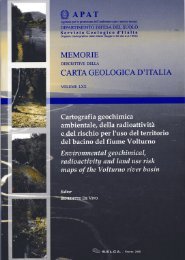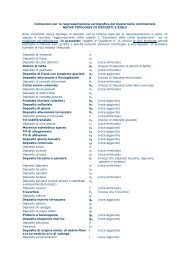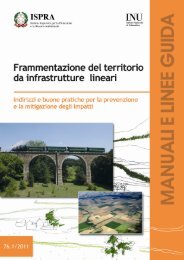Guidebook - Ispra
Guidebook - Ispra
Guidebook - Ispra
You also want an ePaper? Increase the reach of your titles
YUMPU automatically turns print PDFs into web optimized ePapers that Google loves.
Volume n° 1 - from PR01 to B15<br />
B12<br />
B12 -<br />
Leader: M. Sandulescu<br />
Stop 1.4:<br />
Frasin.<br />
The locality of Frasin is situated at the confluence<br />
of Suha Bucovineană with the Moldova. On the<br />
left-hand (northern) bank of Moldova, in an imbricated<br />
structure, also belonging to the Tarcău Nappe,<br />
several Senonian and Paleocene sequences crop out.<br />
The Hangu Formation is a Senonian calcareous<br />
turbiditic (flysch) formation. Two-components (limy<br />
arenites/marls) or three-components (limy arenites/<br />
marls/marly or lithographic limestones) rhythms are<br />
developed. The graded-bedded arenites show at their<br />
basal part grains of “Green Schists”, limestones and<br />
fragments of Inoceramus. Ammonites, inocerams<br />
and a rich pelagic foraminifer assemblage (Ion-<br />
Săndulescu, 1975; Antonescu et al., 1989) document<br />
the Senonian age for the Hangu Formation. The Paleocene<br />
is represented by the Putna Formation. This is<br />
a sandy/marly flysch with a two-component rhythms<br />
in which the sandstones are rather dominant in thickness.<br />
The arenitic material is of polymictic type (as<br />
for the Hangu Formation) containing “Green Schists”<br />
too. The Paleocene age (Antonescu et al., 1989) is<br />
supported by a rich pelagic microfauna and by scarce<br />
examples of Dyscocyclina. The Straja Formation is<br />
younger than the Putna one. It is a variegated flysch<br />
built up by two-component rhythms in which the<br />
arenites are polymictic, with a silica matrix and the<br />
pelites are red-purplish, green and grey. Glauconite<br />
may be frequent in the sandstones. The age of this<br />
formation is (according to the microfaunal content)<br />
Uppermost Paleocene-Lower Ypresian. The source<br />
area for the Straja arenites is external (Foreland), as<br />
well as for the whole Cretaceous-Paleogene-Lower<br />
Miocene succession of the external part of the Tarcău<br />
Nappe as well as those of the Marginal Folds and<br />
Subcarpathian nappes.<br />
Stop 1.5:<br />
Vama.<br />
The locality of Vama is situated in an area corresponding<br />
to the inner subunit (digitation) of the Tarcău<br />
Nappe, the Vama Digitation respectively. On both<br />
banks of the Moldova River the Paleogene formations<br />
of the digitation crop out. The oldest sequence (cropping<br />
out) is the Moldoviţa Sandstone. It represents a<br />
sandy flysch with mica-rich arenites, which prevail in<br />
respect to the clayey pelites, within two-component<br />
rhythms of 30-100 cm. The arenitic material proceeds<br />
from an internal (Carpathian) source situated<br />
in the Central-East Carpathians and the innermost<br />
nappes (Black Flysch, Ceahlău) of the Flysch Zone.<br />
The age, according to the agglutinated foraminifera<br />
associations, is Lower-Middle Eocene, possibly uppermost<br />
Paleocene also. Some red-purplish shales are<br />
inlayered at different levels. Above the Moldoviţa<br />
Sandstone follows the Plopu Formation (see Stop<br />
1.3). The Lower Oligocene sequences are developed<br />
in two lithofacies. In the external scales of the Vama<br />
Digitation, above the Plopu Formation, the Lower<br />
Menilites and the Lower Dysodilic Shales crop out,<br />
as in the more external zones (see above). In the inner<br />
scale of the Vama Digitation above the Plopu Formation<br />
the “Shaly Horizon” with grey, dark-grey and<br />
blackish clays and silts, thin sandstone inlayering and<br />
also rare, sideritic pelagic limestones are developed.<br />
It is an equivalent of the Lower Menilites and Lower<br />
Dysodilic Shales. In the inner parts, the Fusaru Sandstone<br />
follows. This is a massive, micaferous sandstone,<br />
lithologically similar to the Tarcău Sandstone,<br />
proceeding from the same source area (Carpathian).<br />
In the outer part of the Vama Digitation the Fusaru<br />
Sandstone is mixed with Kliwa Sandstone, stressing<br />
out their interfingering. The youngest sequence is<br />
the Vineţișu Formation, a two-component flysch<br />
with limy arenites, often convolute, and marls. The<br />
Oligocene/Lower Miocene boundary runs within it<br />
(fide Săndulescu et al., 1995).<br />
In Prisaca Dornei the front part of the Audia Nappe,<br />
which overthrusts the Tarcău one, is well expressed<br />
in relief.<br />
Stop 1.6:<br />
West of Prisaca Dornei.<br />
On the left-hand bank of the Moldova River, 700<br />
m west of the western border of Prisaca Dornei village,<br />
massive sandstones representing the Prisaca<br />
Sandstone crop out. This is the youngest formation<br />
of the Audia Nappe in this area; its age is Maastrichtian-Lutetian<br />
(Săndulescu et al., 1992). The arenitic<br />
material of the Prisaca Sandstone, polymictic, rich,<br />
mica-bearing, proceeds from the Carpathian source.<br />
In the analysed outcrop it is possible to observe “soft<br />
pebbles” (“galets mous”) of “Black Shales” reworked<br />
by the fluxoturbiditic currents - perhaps in submarine<br />
canyons - from the Lower Cretaceous “Black Shale”<br />
Formation of the same sedimentary basin. 100-200 m<br />
downstream from the outcrop slided variegated shales<br />
may be observed which represent the condensed sequence<br />
of the Vraconian-Lower Senonian (the “Variegated<br />
Clay” Formation) situated between the Prisaca<br />
Sandstone and the “Black Shale” Formation.



